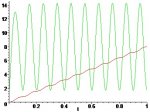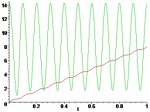moremathlearner
New member
- Joined
- Jul 16, 2017
- Messages
- 4
Could anyone please help me to solve the following question:
Two persons are running along separate path. The first is running at 2 pie km/hr along a circular track with a radius of 100 meter, while the second is running along the straight path, tangent to the first, at a rate of 8 km/hr. They both begin running from the point where the paths meet and at the same time.
How fast is the distance between them changing after an hour.
Thank you for your time.
Two persons are running along separate path. The first is running at 2 pie km/hr along a circular track with a radius of 100 meter, while the second is running along the straight path, tangent to the first, at a rate of 8 km/hr. They both begin running from the point where the paths meet and at the same time.
How fast is the distance between them changing after an hour.
Thank you for your time.


